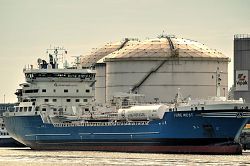

The Health and Safety Executive (HSE) have issued a safety notice after high concentrations of hydrogen sulphide (H2S) were identified in ullage spaces of cargo and slop tanks.
This safety notice is aimed at operators of floating production storage and offloading (FPSO) and floating storage and offloading (FSO) vessels and floating storage units (FSU) in the UK continental shelf (UKCS), after the HSE discovered high concentrations (up to 16,000ppm) in ullage spaces of cargo and slop tanks onboard some FPSOs and FSUs.
Hydrogen sulphide can be generated by sulphate-reducing bacteria that are present in cargo and slop tanks, particularly those containing oil with high water cut. It is a corrosive gas which:
A key issue raised by the HSE is that such high concentrations of hydrogen sulphide are above the upper measuring limits of standard portable gas monitoring equipment generally used onboard tankers and FPSOs. Consequently, their presence may be undetected as personnel using standard equipment to monitor the tank atmosphere may be unaware of these high concentrations.
There is also a risk of exposure to hydrogen sulphide during operations that involve breaching containment, unintentional release to poor pipework or during venting operations to maintain cargo pressure. The toxic gas released from these operations may not be dispersed in low wind conditions and may accumulate in pockets onboard and offshore installations.
Gas monitoring in cargo tank ullage spaces also requires gas to be diverted to measuring equipment prior to being vented. The venting of inert gas which contains high levels of hydrogen sulphide, of an unknown concentration, without appropriate control measures, could expose the crew to the effects of hydrogen sulphide.
In order to manage the risks posed by hydrogen sulphide in these environments, the HSE have set out required actions to control and reduce the risk. The safety notice sets out advice on:
For more information, see: HSE safety notice - High concentration of hydrogen sulfide (H2S) in cargo and slop tanks.